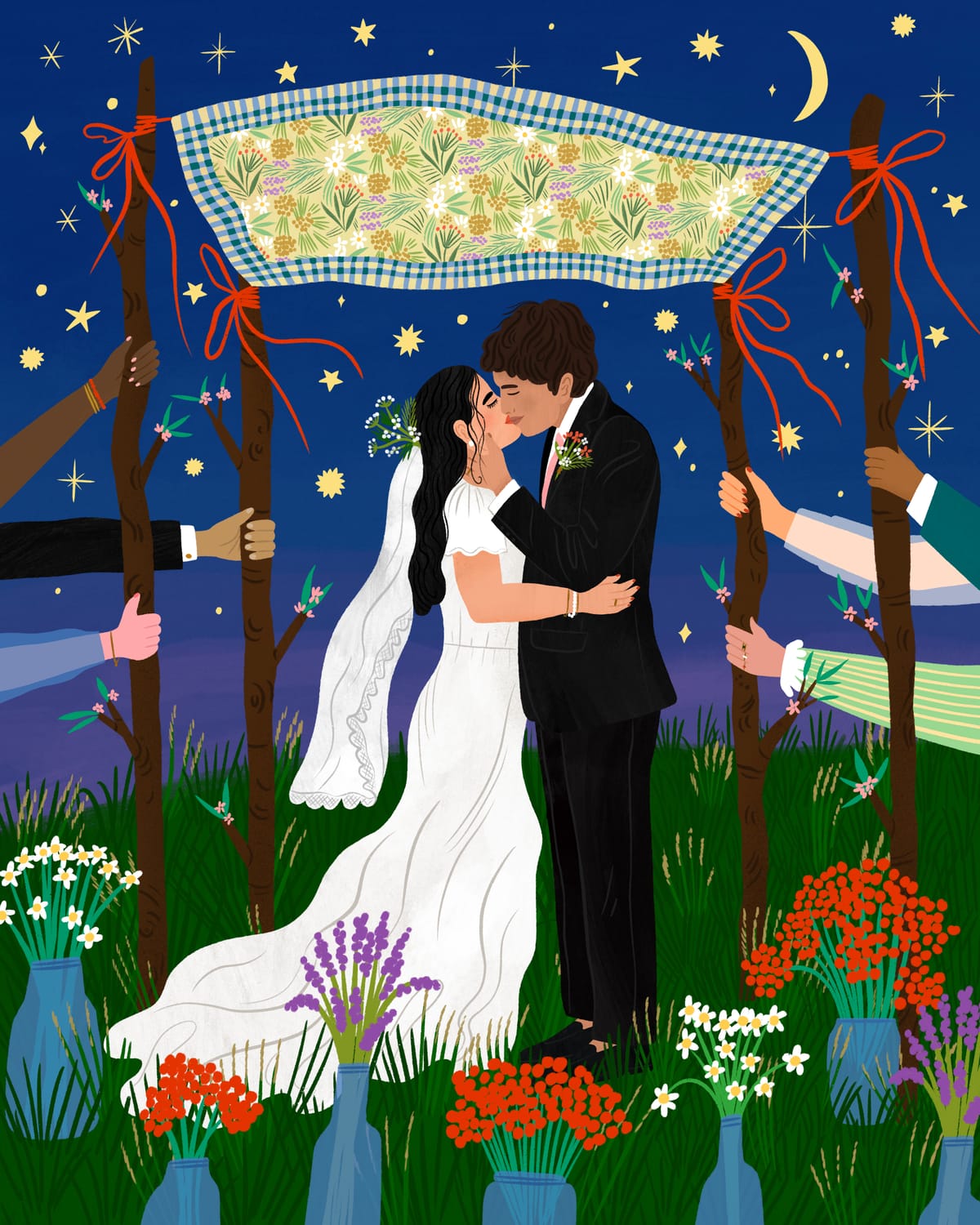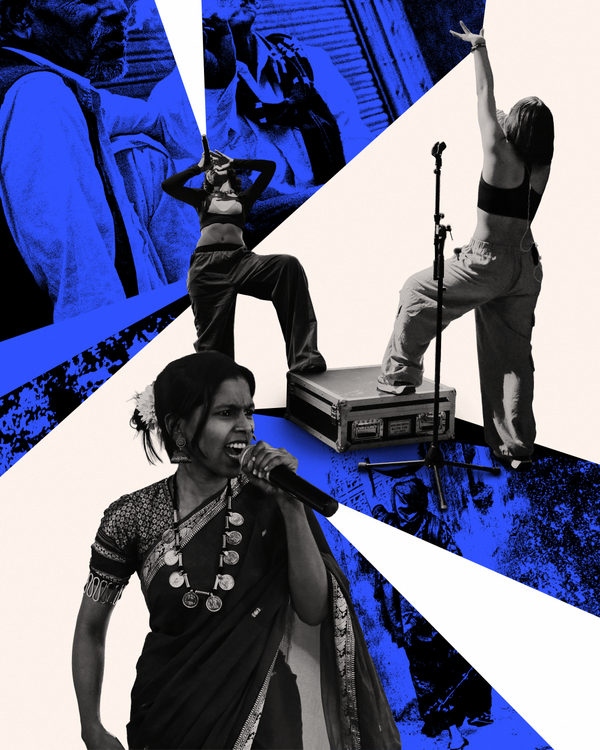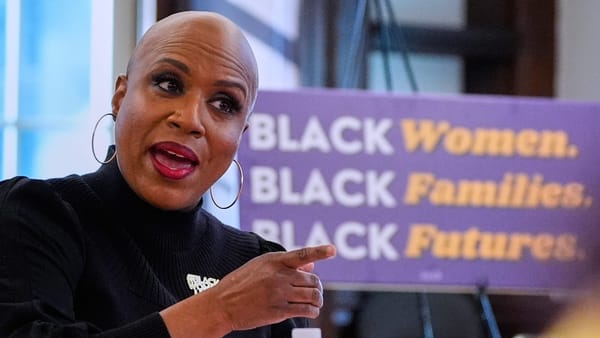A Wedding Today Costs How Much? I’m Glad You Asked.
When my daughter was married last month, we bypassed everything extravagant, opting instead for a wedding built on friends, community and love.

The first story I ever produced for Dateline NBC was on the high cost of weddings. The average cost that year, 1994, was approximately $7000, give or take several thousand, depending on the city, venue, and number of guests. I’d pitched the story the day I started that job because I’d just walked down the aisle at my own wedding and I was still reeling from sticker shock. To give just one example: My then parents-in-law—they are now dead, as is my marriage—insisted that the meal we serve to our guests be kosher. Of course, we said, no problem. We’ll just serve meat and fish, no dairy or pork.
No, they said. That’s not enough. The entire kitchen at the venue would have to be blowtorched by a specially trained rabbi, even though only three of the over 200 guests attending—mostly our parents’ friends and relatives, many of whom we’d never met—would be upset, or so we were told, had the kitchen remained un-blowtorched. Could we not just serve those particular observant guests special kosher meals on paper plates, like they do on airplanes?
No, we were told. That would be insulting. To them and to God.
An argument ensued. I lost. The rabbi and his divine blowtorch cost us the entire $6000 budget we’d earmarked for our honeymoon. Which we’d already booked. And would now have to modify but also very much not be able to afford even with modifications. My then salary as a journalist was $34,000 a year. My husband-to-be was still paying off student loans while working as an unpaid intern. This is how we began our married life. In debt. And arguing over a blowtorch.
Fast forward 30 years to 2023. My daughter FaceTimed me to announce that she and the boyfriend whom she’d met in the Peace Corps had just gotten engaged. I was on the subway when she called, heading to have brunch with my then newish partner. I burst into tears as the image of her beaming face appeared then suddenly cut off.
“Are you OK?” asked the stranger next to me, handing me a tissue.
My right hand was in a splint, and the bottom of my face was sewn back onto my gums with two dozen stitches after a car crash. (His fault, not mine. Dude ran a stop sign, and the force of the airbag ripped off the bottom of my face and broke my hand.) I looked like—there’s no other way to say this—a blubbering mess. “Yes! Yes!” I said, dabbing away the tears with my good hand. “My daughter just got engaged!!!”
“Yes! Yes!” I said, dabbing away the tears with my good hand. “My daughter just got engaged!!!”
I leapt off the train at the next stop, in search of a stronger signal, feeling a combination of overwhelming joy and ironic gratitude to the universe for—and I know this sounds nuts—getting in that car crash. How else would I have had a sudden and unexpected windfall drop into my bank account, literally days before my daughter announced her engagement? I googled “average cost of wedding 2023.” Answer: $29,000. Nearly the exact amount of my insurance payout for pain and suffering.
Before we get ahead of ourselves, let’s sit with that amount for a moment: According to the Consumer Price Index calculator, $1 in 1994 would be worth $2.07 in 2023. Meaning, if the cost of weddings had kept pace with inflation since my Dateline exposé, the average cost of a wedding in 2023 should be around $14,490, not $29,000.
‘This Is Your Wedding, Not Mine’
“I want you to understand that this is your wedding, not mine,” I said to my daughter, when I finally connected with her. “I will follow your lead wherever it goes.” I could say this without worrying about the costs ballooning because my daughter is even more frugal than I. Like many children of formerly single mothers, she has a keen understanding of what it means to do more with less. And like many newly minted doctors exiting medical school, she is saddled with $280,000 of student loan debt.
I offered to throw the wedding in Brooklyn, close to where we live, but we quickly realized this was totally out of our budget. To even walk through the door of most venues in New York City or its nearby environs we’d be paying around $20,000 minimum. Never mind that the average cost of a wedding in the city, in 2023, was $63,000.
Like many children of formerly single mothers, she has a keen understanding of what it means to do more with less. And like many newly minted doctors exiting medical school, she is saddled with $280,000 of student loan debt.
Thankfully, my daughter had other plans anyway. Since all of her medical school friends also have a hefty six figures in student loan debt, she would do it locally, near their school and her friends’ apartments in Buffalo. She didn’t want to ask her fellow debtors, er, doctors to shell out all those associated and expensive travel costs of attending her wedding. And this was before Congress passed Trump’s domestic policy bill, which, should it pass the Senate, will end the Public Service Loan Forgiveness program; keep thousands of new doctors in debt forever; prevent aspiring physicians of more modest means from ever becoming doctors; and make it that much more difficult for the average American to find a doctor.
Moreover, she was imagining getting married out in nature, among the trees, and upstate New York felt as good a place as any.
The Planning Begins
To that end, my daughter and her fiancé—who, up until his job was massacred by Elon Musk’s chainsaw, had been working as a data analyst for USAID (RIP)—would do the legwork on the weekends to find an affordable place among the trees within driving distance of Buffalo. And they would throw the wedding in May 2025, the week after my daughter’s medical school graduation, during the brief window between rotations and residency. Meanwhile, we would lock in a price and put a downpayment on a venue as soon as possible. The rest of it we would do ourselves (hello wedding DIY) as much as humanly possible, and we would keep the guest list lean by not inviting my friends or my ex-husband’s except for one couple each, and they had to have known and loved my daughter since her birth. Again, this was her wedding, not ours, and we were happy to make this concession.
Good planning, as it turned out, as the average cost of a wedding in the U.S. rose from $29,000 to a whopping $36,000 in 2025. Which, well, don’t get me started…
After several weekends of venue searching and inquiries, the lovebirds settled on a farm within an hour’s drive of Buffalo owned by a lovely woman who started renting out the barn and field on her property during Covid, when her son’s venue was cancelled eight days before his wedding. She deliberately keeps her prices low. The cost for this venue, including all tables, chairs, dishes, cutlery, vases and various table decor, folding chairs for the ceremony, day-of workers, etc., etc., was $4500.
Details, Details
The farm offered white tablecloths for free as part of the package, but my daughter wanted a less formal look, so we splurged and found 18 wholesale burlap tablecloths online for $18 each—an auspicious chai—and decided to donate all but one of them to the venue—so the next bride and groom who get married there will have an additional tablecloth option to choose from; and we’ll have a lovely wedding keepsake for our next Thanksgiving table.
The runners we bought for $6.99 each on Amazon, but I’d like to point out that we did this before Bezos went MAGA. We also bought four 7-foot birch logs for the chuppah (the wedding canopy) for $79.99. To these logs we attached a floral tablecloth ($89) from my late best friend’s favorite fabric store in Paris, to have a part of her with us—she was quite close to my daughter, too, and just died in December—by asking my local cobbler to pierce four sneaker grommets into each corner of the cloth so we could then attach it to the birch logs with two pairs of $2 white shoelaces. The repairman at Bob’s Shoe and Leather Service in Park Slope was slightly puzzled by this request, but he gamely did the work and even added tiny leather backings behind each grommet, for added strength, for a grand total of $6.
And Now For the Flowers
Wedding flower budgets can be exorbitant, running anywhere from around $2500, minimum, to a hefty six figures for more deluxe arrangements, so my daughter asked if I wouldn’t mind being the florist, and her bridesmaids would simply each make their own bouquets as a fun morning activity before the wedding. To that end, my sister Jen and I hopped in a car at 7:00 a.m. on the morning of the wedding and drove an hour to the second closest Trader Joe’s. We’d meant to drive 40 minutes to the closest Trader Joe’s, but, pre-coffee, I took a wrong turn onto a highway with no exits for another 34 miles, so we ended up in Rochester instead of Buffalo. We arrived at 8:00 a.m. on the dot, right after the morning flower delivery and just in time to go head-to-head with a bunch of hungover bridesmaids in sweatpants, giddily filling their carts with blossoms for their cost-conscious brides. And then—oh no!—there were also hordes of Mother’s Day crowds getting an early start on their bouquets. How had we forgotten about Mother’s Day?
We arrived at 8:00 a.m. on the dot, right after the morning flower delivery and just in time to go head-to-head with a bunch of hungover bridesmaids in sweatpants.
“It’s like a flower roller derby!” my sister and I joked, elbowing out our competition for bunches of baby’s breath, tulips, roses, and lilies.
“Here, have a bucket,” said the nice Trader Joe’s worker, seeing how many flowers we’d already managed to procure and load into our cart.
“Thanks,” I said. “Do you have 10 more?”
She laughed. “Of course.”
Total cost for two giant shopping carts filled with flowers, which my sister kindly offered to cover—$413. That's for all of the flowers we would ever need and then some, which my three sisters, my cousin, my aunt, and my mom arranged in the bud vases provided by the venue, where they met us at 9 a.m. to join in our efforts. Meanwhile, the bridesmaids and my daughter were busy creating their bouquets, which they bound with the pretty ribbon my Aunt Marilyn happened to have lying around her house and remembered to bring.
I was also tasked with being the calligrapher for all the place cards, which saved us another $400 or so (at $2.50 to $3.00 per card). Was my handwriting perfect? It was not. I learned calligraphy in 7th grade, to make a few extra bucks addressing bar and bat mitzvah invitations, and I haven’t used those skills since, but I made it through the 150 cards in about four hours without too many mistakes.
The Community Steps Up
Friends—grade school, high school, college, Peace Corps, med school, and on and on—rallied to the cause as well, providing often costly services for free. Ben, my daughter’s friend since they were infants, was the officiant, which saved us somewhere between $350 and $800 and had us all guffawing and crying in equal measure. Emily, my daughter’s medical-school classmate, spent weeks perfecting and baking a gorgeous gluten-free wedding cake for my Celiac-afflicted daughter, which saved us another thousand dollars or so. She also hosted a large welcome dinner in her cozy apartment with Emme and Leta, my daughter’s high school buddies, who had just completed their Master’s in Food Studies in Italy and did all the cooking with my ex-husband. My mother, who used to spend hours watching “Say Yes to the Dress” with my daughter, offered not only to pay for her granddaughter’s dress and wedding coordinator but also to be the flower girl.
My mother, who used to spend hours watching “Say Yes to the Dress” with my daughter, offered not only to pay for her granddaughter’s dress and wedding coordinator but also to be the flower girl.
My community stepped in as well. My friend Steph, a brilliant writer and photographer, offered to shoot the wedding gratis, as a gift to the young couple, saving us somewhere between $2500 and (a cool) $50,000. My two sons learned and performed several songs on the guitar, providing the pre-wedding and processional music, which saved us another $1000 or more. Mary and Jeff, the groom’s parents, did a giant Costco and liquor store run for soft drinks and alcohol. That same day, my daughter and I went to Walmart to buy ingredients for s’mores, materials for beer pong, and of course the essential late-night snacks.
My life partner of three years, who has grown to love and care for my daughter and son-in-law as much as I, volunteered to pay for all the food. Pat, from the local barbecue joint, Pat’s Pigs, said he could cook onsite for $4000. And then there were additional costs of around $2000 for appetizers, including a charcuterie board and trays of finger-food desserts—all procured locally. (Yes, yes, I am aware that both my former in-laws and the rabbi who blowtorched my wedding 32 years ago definitely would not have approved of Pat and his pigs or the charcuterie board, but the food was amazing; and it didn’t break the bank.)
Later, we danced, thanks to a $1900 DJ, to excellent music and a rousing Hava Nagila hora, because that’s part of our heritage, like getting married under a simple canopy, we still love and cherish. And now my daughter and her husband are just back from their honeymoon, which was funded by my three sisters, the officiant’s parents—friends of both mine and my daughter’s, who also gamely hosted her bachelorette party—and by smaller donations from the newlyweds’ Gen-Z friends, a generation which values experiences over things.
‘Everywhere You Look’
“Everywhere you look is a tightly knit, carefully chosen community,” I said in my toast, honoring the guests in that room, all of whom had been directly involved in making the night special. “For what is community other than a deliberate tapestry sewn of love? And what is love other than the only antidote to our current regime’s shameful and toxic lack of empathy?” The entire barn erupted in applause at that line. I had neither expected nor planned for this reaction, mid-toast, but I understood why it was happening. All of those Peace Corps volunteers, perhaps the last of their breed; my new son-in-law, forced out of USAID by a chainsaw-wielding drug addict; dozens of recently minted doctors—all of whom were now worried about paying off their student loans on top of paying for housing, food, children, their own weddings—they all needed a release valve for their anger and anxiety. Even before fascism became all the rage, late-stage capitalism had already ceased making room for choosing caregiving over wealth-building; patients over profits; cooperating as a community to build a wedding together—flower by flower, song by song, cake by words by photos by place cards—over outsourcing the entire celebration.
And yet it was the very nature of that shared effort—less DIY, as it turned out, and more DIWO (do it with others)—at a time billionaires are being given tax cuts; and doctors are going into debt to save our lives; and cancer research and Medicaid are getting defunded; and immigrants, the underpaid backbone of our economy, are being disappeared into far away prisons without due process; that made my daughter and son-in-law’s wedding so meaningful. And moving. And full of Puck-ish, fairy dust love. Not only for them but for all of us. Yes, even this divorced and formerly-cynical-about-love mother-of-the-bride.
At the end of the night, my love and I snuck away from the dance floor, walked down the now empty but still flower-strewn aisle, and practiced exchanging our own vows under a nearly full moon, whose light and glow are always free and frankly miraculous. We can’t get married right now for real, for complicated if important reasons, but it was the most romantic, least expensive pretend wedding I’ve ever had. (Plus, I would be remiss not to add, a twofer!) Of course, when we finally do say our vows, whether in front of a clerk at City Hall or on some public beach near our home, I, too, will carry flowers from Trader Joe’s. Then I imagine we’ll all go out for pizza and call it a day. 💐





